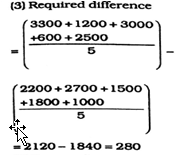Digitization help student to explore and study their academic courses online, as this gives them flexibility and scheduling their learning at their convenience. Kidsfront has prepared unique course material of Quantitative Aptitude Bar diagram for SSC CGL Exam student. This free online Quantitative Aptitude study material for SSC CGL Exam will help students in learning and doing practice on Bar diagram topic of SSC CGL Exam Quantitative Aptitude. The study material on Bar diagram, help SSC CGL Exam Quantitative Aptitude students to learn every aspect of Bar diagram and prepare themselves for exams by doing online test exercise for Bar diagram, as their study progresses in class. Kidsfront provide unique pattern of learning Quantitative Aptitude with free online comprehensive study material and loads of SSC CGL Exam Quantitative Aptitude Bar diagram exercise prepared by the highly professionals team. Students can understand Bar diagram concept easily and consolidate their learning by doing practice test on Bar diagram regularly till they excel in Quantitative Aptitude Bar diagram.
 Study the bar diagram and answer the question.
Study the bar diagram and answer the question..png) Percentage fall in value from 2000 to 2001 is
Percentage fall in value from 2000 to 2001 is Correct Answer Is : None of these
Correct Answer Is : None of these Study the bar diagram and answer the question.
Study the bar diagram and answer the question..png) The difference between the bags exported in 1999 and 2000 was
The difference between the bags exported in 1999 and 2000 was Correct Answer Is : 1,00,000,00
Correct Answer Is : 1,00,000,00 Study the bar diagram and answer the question.
Study the bar diagram and answer the question..png) Value per bag was minimum in the year
Value per bag was minimum in the year Correct Answer Is : 1996
Correct Answer Is : 1996 Study the bar diagram and answer the question.
Study the bar diagram and answer the question..png) The approximate percentage increase in quantity from 1997 to 1998 was
The approximate percentage increase in quantity from 1997 to 1998 was Correct Answer Is : None of these
Correct Answer Is : None of these In the following bar chart represents the number of first year B.Com. Students of St Xavier`s College using different company`s smart phones. Study bar chart and answer the question.
In the following bar chart represents the number of first year B.Com. Students of St Xavier`s College using different company`s smart phones. Study bar chart and answer the question..png)
 Correct Answer Is : 13:12
Correct Answer Is : 13:12 In the following bar chart represents the number of first year B.Com. Students of St Xavier`s College using different company`s smart phones. Study bar chart and answer the question.
In the following bar chart represents the number of first year B.Com. Students of St Xavier`s College using different company`s smart phones. Study bar chart and answer the question..png)
 Correct Answer Is : 18.52%
Correct Answer Is : 18.52% In the following bar chart represents the number of first year B.Com. Students of St Xavier`s College using different company`s smart phones. Study bar chart and answer the question.
In the following bar chart represents the number of first year B.Com. Students of St Xavier`s College using different company`s smart phones. Study bar chart and answer the question..png)
 Correct Answer Is : 31.58%
Correct Answer Is : 31.58% In the following bar chart represents the number of first year B.Com. Students of St Xavier`s College using different company`s smart phones. Study bar chart and answer the question.
In the following bar chart represents the number of first year B.Com. Students of St Xavier`s College using different company`s smart phones. Study bar chart and answer the question..png)
 Correct Answer Is : 80
Correct Answer Is : 80 Study the bar diagram and answer the following question.
Study the bar diagram and answer the following question..png)
 Correct Answer Is : 3:02
Correct Answer Is : 3:02 Study the bar diagram and answer the following question.
Study the bar diagram and answer the following question..png)
 Correct Answer Is : 280
Correct Answer Is : 280